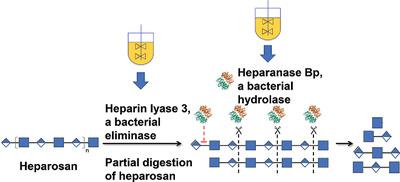当前位置:
X-MOL 学术
›
Biotechnol. J.
›
论文详情
Our official English website, www.x-mol.net, welcomes your
feedback! (Note: you will need to create a separate account there.)
Heparosan Chain Characterization: Sequential Depolymerization of E. Coli K5 Heparosan by a Bacterial Eliminase Heparin Lyase III and a Bacterial Hydrolase Heparanase Bp to Prepare Defined Oligomers
Biotechnology Journal ( IF 3.2 ) Pub Date : 2020-10-01 , DOI: 10.1002/biot.202000336 Payel Datta 1 , LuFeng Yan 1, 2 , Adeola Awofiranye 1 , Jonathan S. Dordick 1, 3 , Robert J. Linhardt 1, 2, 3
Biotechnology Journal ( IF 3.2 ) Pub Date : 2020-10-01 , DOI: 10.1002/biot.202000336 Payel Datta 1 , LuFeng Yan 1, 2 , Adeola Awofiranye 1 , Jonathan S. Dordick 1, 3 , Robert J. Linhardt 1, 2, 3
Affiliation

|
Heparosan is a non‐sulfated polysaccharide and potential applications include, chemoenzymatic synthesis of heparin and heparan sulfates. Heparosan is produced using microbial cells (natural producers or engineered cells). The characterization of heparosan isolated from both natural producers and engineered‐cells are critical steps towards the potential applications of heparosan. Heparosan is characterized using 1) analysis of intact chain size and polydispersity, and 2) disaccharide composition. The current paper describes a novel method for heparosan chain characterization, using heparin lyase III (Hep‐3, an eliminase from Flavobacterium heparinum) and heparanase Bp (Hep‐Bp, a hydrolase from Burkholderia pseudomallei). The partial digestion of E. coli K5 heparosan with purified His‐tagged Hep‐3 results in oligomers of defined sizes. The oligomers (degree of polymerization from 2 to 8, DP2‐DP8) are completely digested with purified GST‐tagged Hep‐Bp and analyzed using gel permeation chromatography. Hep‐Bp specifically cleaves the linkage between d‐glucuronic acid (GlcA) and N‐acetyl‐d‐glucosamine (GlcNAc) but not the linkage between 4‐deoxy‐α‐L‐threo‐hex‐4‐enopyranosyluronic acid (deltaUA) and GlcNAc, and results in the presence of a minor resistant trisaccharide (GlcNAc‐GlcA‐GlcNAc). This method successfully demonstrated the substrate selectivity of Hep‐BP on heparosan oligomers. This analytical tool could be applied towards heparosan chain mapping and analysis of unnatural sugar moieties in the heparosan chain.
中文翻译:

肝素链表征:通过细菌消氨酶肝素裂解酶III和细菌水解酶乙酰肝素酶Bp顺序解聚大肠杆菌K5肝素,以制备确定的寡聚体
肝素是一种非硫酸化多糖,潜在的应用包括化学合成肝素和硫酸乙酰肝素。肝素是使用微生物细胞(天然产生者或工程细胞)产生的。从天然生产者和工程细胞中分离出的肝素的表征是实现肝素潜在应用的关键步骤。肝素的特征在于1)分析完整的链大小和多分散性,以及2)二糖组成。当前的论文描述了一种新的肝素链表征方法,该方法使用肝素裂解酶III(Hep-3,一种来自黄杆菌的消除酶)和乙酰肝素酶Bp(Hep-Bp,一种来自Burkholderia pseudomallei的水解酶)。大肠杆菌的部分消化具有纯化的带His标签的Hep-3的K5肝素酶可产生确定大小的寡聚体。用纯化的带GST标签的Hep-Bp完全消化低聚物(聚合度从2到8,DP2-DP8),并使用凝胶渗透色谱法进行分析。Hep-Bp特异性切割d-葡萄糖醛酸(GlcA)与N-乙酰基d之间的联系葡糖胺(GlcNAc),但不存在4-脱氧-α-L-苏-六-4-烯吡喃糖基糖醛酸(deltaUA)和GlcNAc之间的联系,并导致存在次要抗性三糖(GlcNAc-GlcA-GlcNAc)。该方法成功证明了Hep-BP对肝素寡聚体的底物选择性。该分析工具可用于肝素链图谱分析和肝素链中非天然糖部分的分析。
更新日期:2020-10-01
中文翻译:

肝素链表征:通过细菌消氨酶肝素裂解酶III和细菌水解酶乙酰肝素酶Bp顺序解聚大肠杆菌K5肝素,以制备确定的寡聚体
肝素是一种非硫酸化多糖,潜在的应用包括化学合成肝素和硫酸乙酰肝素。肝素是使用微生物细胞(天然产生者或工程细胞)产生的。从天然生产者和工程细胞中分离出的肝素的表征是实现肝素潜在应用的关键步骤。肝素的特征在于1)分析完整的链大小和多分散性,以及2)二糖组成。当前的论文描述了一种新的肝素链表征方法,该方法使用肝素裂解酶III(Hep-3,一种来自黄杆菌的消除酶)和乙酰肝素酶Bp(Hep-Bp,一种来自Burkholderia pseudomallei的水解酶)。大肠杆菌的部分消化具有纯化的带His标签的Hep-3的K5肝素酶可产生确定大小的寡聚体。用纯化的带GST标签的Hep-Bp完全消化低聚物(聚合度从2到8,DP2-DP8),并使用凝胶渗透色谱法进行分析。Hep-Bp特异性切割d-葡萄糖醛酸(GlcA)与N-乙酰基d之间的联系葡糖胺(GlcNAc),但不存在4-脱氧-α-L-苏-六-4-烯吡喃糖基糖醛酸(deltaUA)和GlcNAc之间的联系,并导致存在次要抗性三糖(GlcNAc-GlcA-GlcNAc)。该方法成功证明了Hep-BP对肝素寡聚体的底物选择性。该分析工具可用于肝素链图谱分析和肝素链中非天然糖部分的分析。









































 京公网安备 11010802027423号
京公网安备 11010802027423号